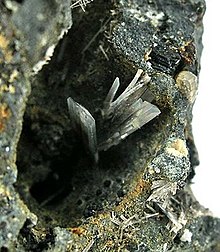| Laurionite | |
|---|---|
 Laurionite crystals in a vug from the Laurium district of Greece | |
| General | |
| Category | Halide minerals |
| Formula (repeating unit) | PbCl(OH) |
| IMA symbol | Lri[1] |
| Strunz classification | 3.DC.05 |
| Crystal system | Orthorhombic |
| Crystal class | Dipyramidal (mmm) H-M symbol: (2/m 2/m 2/m) |
| Space group | Pnma |
| Unit cell | a = 7.111, b = 9.6987 c = 4.0203 [Å]; Z = 4 |
| Identification | |
| Color | Colorless, white |
| Crystal habit | Elongated tabular prismatic crystals |
| Cleavage | Distinct on {101} |
| Tenacity | Flexible |
| Mohs scale hardness | 3–3.5 |
| Luster | Adamantine, pearly |
| Streak | White |
| Diaphaneity | Transparent |
| Specific gravity | 6.241 |
| Optical properties | Biaxial (−) |
| Refractive index | nα = 2.077 nβ = 2.116 nγ = 2.158 |
| Birefringence | δ = 0.081 |
| 2V angle | Measured: 70° |
| Solubility | Sleight in cold water |
| References | [2][3][4][5] |
Laurionite (PbCl(OH)) is a lead halide mineral. It forms colorless to white crystals in the orthorhombic crystal system and is dimorphous with paralaurionite, both members of the matlockite group.[2]
It was first described in 1887 for an occurrence in the Laurium District, Attica, Greece, and named after the town Laurium.[2] It occurs as an oxidation product in lead ore deposits, and is also produced on lead-bearing slag by reaction with saline solutions. It occurs associated with paralaurionite, penfieldite, fiedlerite, phosgenite, cerussite and anglesite.[3]
References
[edit]- ^ Warr, L.N. (2021). "IMA–CNMNC approved mineral symbols". Mineralogical Magazine. 85 (3): 291–320. Bibcode:2021MinM...85..291W. doi:10.1180/mgm.2021.43. S2CID 235729616.
- ^ a b c Mindat.org
- ^ a b Handbook of Mineralogy
- ^ Webmineral data for laurionite
- ^ Mineralienatlas
Well, that’s interesting to know that Psilotum nudum are known as whisk ferns. Psilotum nudum is the commoner species of the two. While the P. flaccidum is a rare species and is found in the tropical islands. Both the species are usually epiphytic in habit and grow upon tree ferns. These species may also be terrestrial and grow in humus or in the crevices of the rocks.
View the detailed Guide of Psilotum nudum: Detailed Study Of Psilotum Nudum (Whisk Fern), Classification, Anatomy, Reproduction